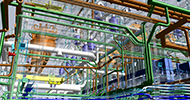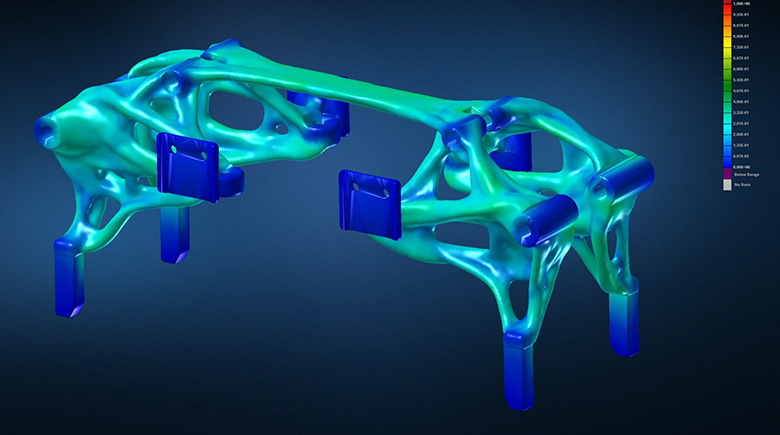Creating a sustainable and livable world for future generations requires innovation. Unlike optimisation, innovation stems from new ideas, new ways of looking at things and it is made real by taking new approaches. Augmenting innovation means lifting ideas by leveraging technology and making data work harder for us.
How can moving processes such as quality testing to an earlier position in the development process help to support innovation? To many, the idea of quality testing is diametrically opposed to the concept of innovation. One embodies the boundless freedom of artistic creativity; the other, the strict scientific assessment of a produced part.
But the two are compatible. In fact, they need each other. And bringing them closer together has the potential to change the way manufacturing operates for good.
The road to zero prototyping
It’s often said that necessity is the mother of invention and few things in manufacturing are more necessary than avoiding quality issues. Shifting testing earlier in manufacturing through increased use of simulation and other technologies means quality issues can be detected and ironed out early, well before anything has been physically manufactured. This effectively accelerates the prototyping phase and keeps it almost entirely in the virtual world, opening up more avenues for product designers to really stretch their creative abilities.
Computer simulation has been around for many years, but technology is now taking us to new places and giving us abilities that only a few years ago would have seemed unimaginable within manufacturing.
Processing power is an important aspect, but generative design and digital twin technologies are at the forefront of augmenting people’s ability to innovate faster. For more information on this, see our eBook: Closing the loop with zero prototyping.
Generative design
Generative design is a process that uses algorithms to run countless iterations based on the specific constraints, or goals, set by the programmer. As technology has no lived preconceptions of how a product normally looks, it can design to brief a solution that no human could ever conceive. This is what gives the designs their incredible distinctive look often achieved with additive manufacturing.
The designer can prioritise in their brief qualities such as strength, stability or material usage depending on the particular use case requirements. The process significantly reduces the need for prototype iterations and the chance of discovering quality issues late in the process, enabling designers to truly explore possibilities and let their creativity flow.
Multiple options for the design can be created, each satisfying the original criteria but taking different approaches. This again massively speeds up what would traditionally have been a time-consuming process, empowering manufacturers to accelerate decision making and reduce time-to-market.
Generative design has opened up entirely new product approaches. Inspired by AI, developers are experimenting with the potential offered by consolidating parts or systems, such as single housings for braking and suspension systems in automotive. With fewer parts joined together, designs can be simplified and weight reduction achieved.
The way generative design thinks, the way it analytically rather than creatively views challenges through data analysis, opens up a whole new world for design. This is a world of potential that is only just beginning to reveal itself.
Augmenting innovation with digital twins
The term ‘digital twin’ has become common parlance. but its meaning has stretched over time. Of course, it essentially means a virtual replica of a physical product or process, but technology is again providing broader capabilities. More than a static digital representation, digital twins are, or have the potential to be, dynamic and immersive, delivering real-time response to adjustments in the parameters.
When used in this way, digital twins can streamline and accelerate development processes by shifting the discovery and resolution of problems left into the early section of the lifecycle and again enhancing decision making with greater collaborative engineering.
This is a major benefit of digital twins and has the power to transform the way we make everything. The deployment of a realistic and dynamic model within a group of stakeholders totally eclipses the traditional boundaries and silos that hindered timely progress in the past. It also bypasses issues of file sharing, misunderstandings and miscommunication, which may seem insignificant yet regularly accumulate to become major delays and problems later on when resulting costs are far greater.
The important thing to remember with digital twins is that we are not just talking about products. We can transform processes, even entire facilities with digital twin technology and generate data-led insights to promote quality, efficiency and resilience in manufacturing.
A shift of the ages
Taking a step back, it’s clear that the way we use data is transforming significantly, and with it, the way we make things augmenting innovation. Of course, quality inspection at the end of the production line made sense when everything occurs manually. But digital technology doesn’t need to remain fixed to such regimented workflows. The shift left through leveraging simulation software, generative design and digital twins is a continuation of what has been happening throughout the Information Age.
In a world where innovation happens in leaps – fast iteration, rapid scaling of ideas, the immediate simulation of designs and the ability to manufacture flexibly are top priorities. Creating products that accelerate the human experience can no longer happen in isolation. We need to harness technology to augment our ideas. The possibilities are endless.
This blog originally appeared as part of Hexagon’s Shift Left eBook.
- Understand what a ‘Shift Left’ strategy means in manufacturing and its potential to supercharge your operations
- Detailed explanations on how leading-edge technology such as generative design, digital twins, AI and predictive modeling play a vital role
- A comprehensive guide for planning, executing and continually improving a shift left strategy in your organisation
- A 10-step roadmap to implementing shift left, featuring indispensable technological building blocks















